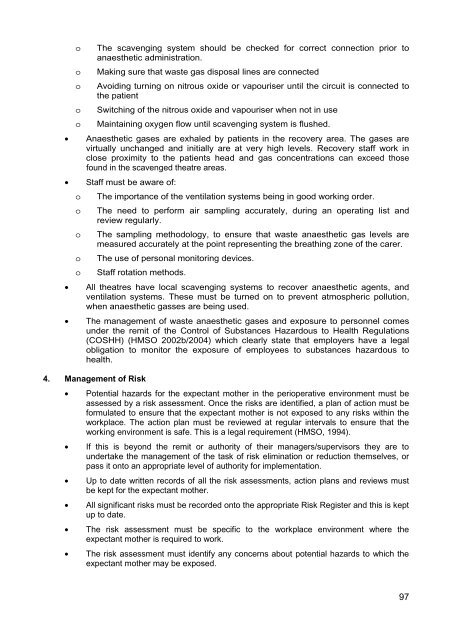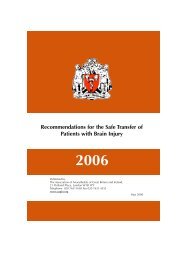TheatrePracticeStandardsGeneric1
You also want an ePaper? Increase the reach of your titles
YUMPU automatically turns print PDFs into web optimized ePapers that Google loves.
o<br />
o<br />
o<br />
o<br />
o<br />
The scavenging system should be checked for correct connection prior to<br />
anaesthetic administration.<br />
Making sure that waste gas disposal lines are connected<br />
Avoiding turning on nitrous oxide or vapouriser until the circuit is connected to<br />
the patient<br />
Switching of the nitrous oxide and vapouriser when not in use<br />
Maintaining oxygen flow until scavenging system is flushed.<br />
• Anaesthetic gases are exhaled by patients in the recovery area. The gases are<br />
virtually unchanged and initially are at very high levels. Recovery staff work in<br />
close proximity to the patients head and gas concentrations can exceed those<br />
found in the scavenged theatre areas.<br />
• Staff must be aware of:<br />
o<br />
o<br />
o<br />
o<br />
o<br />
The importance of the ventilation systems being in good working order.<br />
The need to perform air sampling accurately, during an operating list and<br />
review regularly.<br />
The sampling methodology, to ensure that waste anaesthetic gas levels are<br />
measured accurately at the point representing the breathing zone of the carer.<br />
The use of personal monitoring devices.<br />
Staff rotation methods.<br />
• All theatres have local scavenging systems to recover anaesthetic agents, and<br />
ventilation systems. These must be turned on to prevent atmospheric pollution,<br />
when anaesthetic gasses are being used.<br />
• The management of waste anaesthetic gases and exposure to personnel comes<br />
under the remit of the Control of Substances Hazardous to Health Regulations<br />
(COSHH) (HMSO 2002b/2004) which clearly state that employers have a legal<br />
obligation to monitor the exposure of employees to substances hazardous to<br />
health.<br />
4. Management of Risk<br />
• Potential hazards for the expectant mother in the perioperative environment must be<br />
assessed by a risk assessment. Once the risks are identified, a plan of action must be<br />
formulated to ensure that the expectant mother is not exposed to any risks within the<br />
workplace. The action plan must be reviewed at regular intervals to ensure that the<br />
working environment is safe. This is a legal requirement (HMSO, 1994).<br />
• If this is beyond the remit or authority of their managers/supervisors they are to<br />
undertake the management of the task of risk elimination or reduction themselves, or<br />
pass it onto an appropriate level of authority for implementation.<br />
• Up to date written records of all the risk assessments, action plans and reviews must<br />
be kept for the expectant mother.<br />
• All significant risks must be recorded onto the appropriate Risk Register and this is kept<br />
up to date.<br />
• The risk assessment must be specific to the workplace environment where the<br />
expectant mother is required to work.<br />
• The risk assessment must identify any concerns about potential hazards to which the<br />
expectant mother may be exposed.<br />
97





